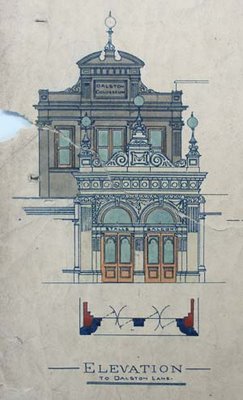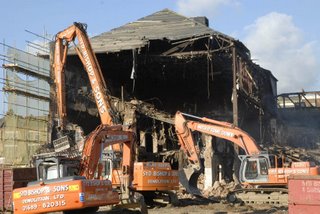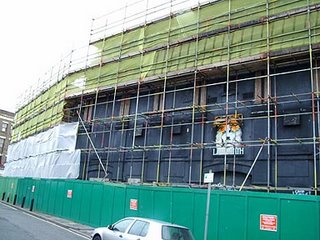
Local artists have also added their comments to TfLs "artist impression" of its proposed tower block development (left click to see the images bigger)

<




The municipal vandals have completed the demolition of Dalston's heritage buildings. They have destroyed the earliest surviving circus entrance in England. This 1886 entrance, with its stepped parapet and Corinthian pilasters, was described as "extremely rare" by the Theatres Trust and as "altogether quite delightful" by English Heritage. It was an urban gem.
The philistines have also destroyed the 1898 entrance to Dalston Variety Theatre, built forward from the circus entrance, and which for 33 years was the home of Newton Dunbar's legendary reggae and soul music club, The Four Aces, and became a second home to international black musicians.
Gone too are the locally listed Georgian houses next door,the earliest in Dalston Lane, which the Council's policy was to "preserve and enhance", and which made up this unique group of historic buildings.
Also destroyed forever is the Dalston Theatre, where Hackney's own international music hall star Marie Lloyd worked and which Compton MacKenzie's father managed. The magnificent interiors became the jewel in Dalston's crown in 1920 when it was converted, at enormous expense, into a cinema. In its final years the Theatre became the home of the Labyrinth Club.
Hackney Council acquired these heritage buildings in 1977 and their destruction began in 1995 when it declared the Theatre a development site. The Theatre's roof was removed, the occupiers evicted, the buildings were boarded up and they ran to ruin whilst the Council awaited offers from developers.
The demolitions have been financed by the London Development Agency, with the agreement and approval of Transport for London and the Greater London Authority.
The government refused to intervene. The authorities said that redevelopment of the site with tower blocks, and children living up to the 20th floor, was essential to finance New Dalston's transport interchange as part of the 2012 Olympic infrastructure. The Council will give TfL the profit from the sale of its site to meet the £39 cost of a concrete slab for a bus station above the rail station
These buildings stood as landmarks in our lives and in the lives of Dalston's previous generations. Since April 2005 OPEN has fought to save something of the site's 185 year diverse cultural history. We informed and worked with the community, we sought to persuade the authorities through consultation, petitions, planning objections and personal contacts. We obtained four Court injunctions to stay their hand. But the forces of municipal vandalism had made up their minds long before the public consultation started and have now achieved their objectives.
The Vandals: an eastern Germanic tribe which earned notoriety by it sacking Rome in the 5th century but which was defeated by the Goths.
Vandalism: the gratuitous anti-social destruction of the environment and artistic creations.
Municipal vandalism: the destruction of our cultural heritage by corporate ignorance, deliberate neglect, vanity and greed all in the name of progress
Hackney Council and Transport for London now have plans to complete the demolition and Croydonisation of the remainder of Dalston Junction. The writing is on the wall.



"We are championing the historic environment and using the Borough’s heritage as a key component of economic regeneration... " Hackney Council, September 2005
Independant environmental consultants, White Young Green, advised the Council "...given the strength of local public feeling towards the site, the nature of the development and the loss of the theatre building in particular...a more detailed analysis of alternative development schemes considered for this site would be helpful...". The Council did not consider any alternative to demolishing these buildings.
English Heritage commented in June 2005 "..parts of the site have a strong historic character...These should be retained where possible and used positively to inform new patterns of development and reinforce the areas character and identity..". The Council officer's report to the Hackney Committee said that English Heritage had not commented.
Ken Livingstone's London Plan prescribes 50% affordable housing in new developments. Hackney Council's Planning Brief for the site prescribed 50% affordable housing and a maximum of 12-15 storeys. The new developments here will have only 24% affordable housing, towerblocks of up to 20 storeys and with families with children living up to the top floor.
The Council's property consultants, Drivers Jonas, stated that "Throughout the project it has been the intention of the client group (ie the landowners Hackney Council and Transport for London) that any land value arising from the Dalston Lane south proposals would contribute to the extraordinary costs of construction of the slab". In other words,they had decided before the public consultation started that Dalston's heritage buildings were to be demolished to pay for TfL's £39million new bus station which is to be built over Dalston station. That cost works out at over £2million per bus stand and Dalston being blighted.
The Council's own architects, Arup Associates Ltd., had proposed in their Environmental Impact Assessment report that an event be held to celebrate the history of Dalston Theatre before its demolition. OPEN had made a similar proposal to the Council. These suggestions have been ignored by the Council. There has been no event to celebrate this building's service which has been to provide public entertainment and performance arts in Dalston for over 120 years.
For a more detailed history of this site, please see the posting below "The story that was never told"
All photos are the copyright of Mike Wells
+44 77 99 152 888





The Philistines
Noun: the natives or inhabitants of ancient Philistia
Adjective: those who pursue only material gain and who place no value on beauty, culture or artistic creations;
Philistinism: the vandalism of our heritage and culture as justified by institutional policy.